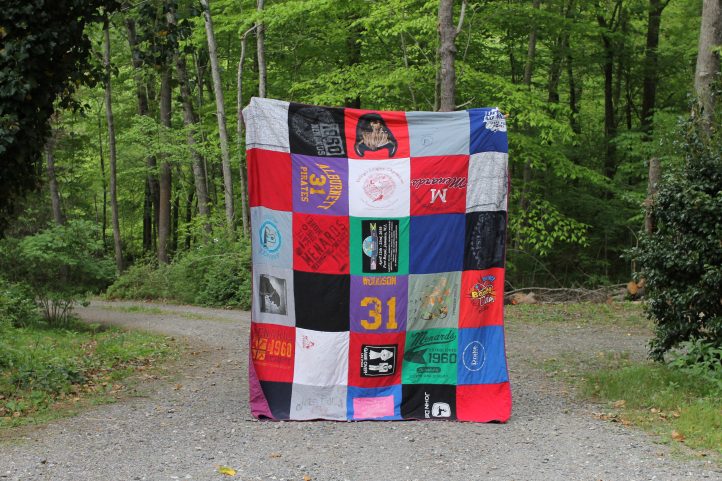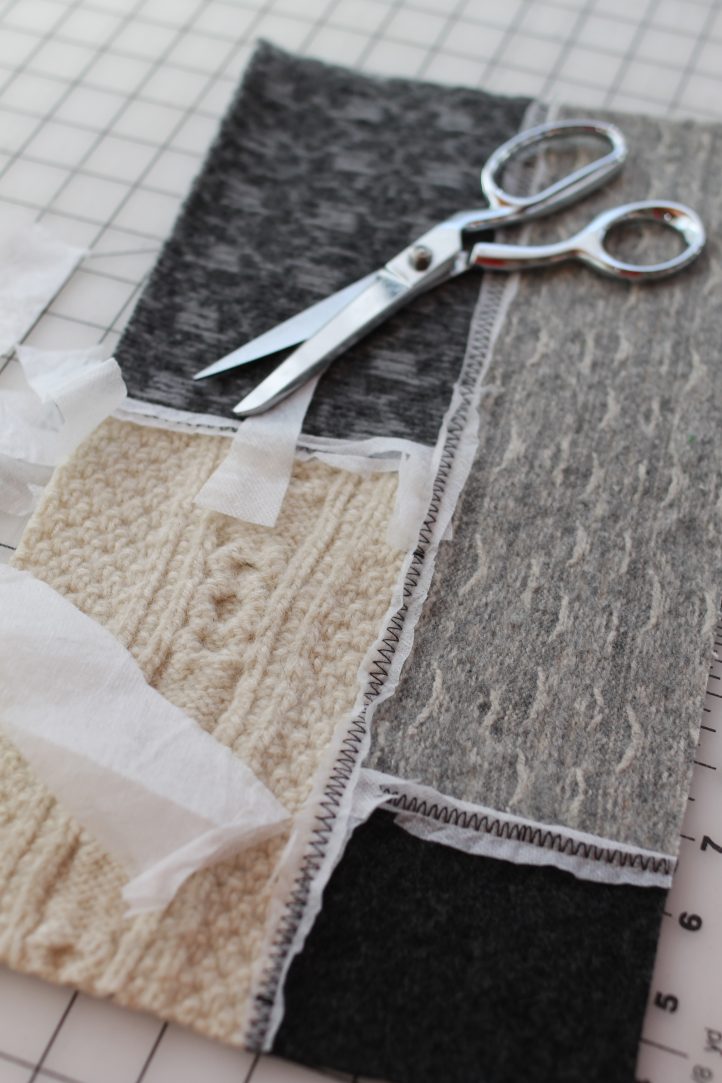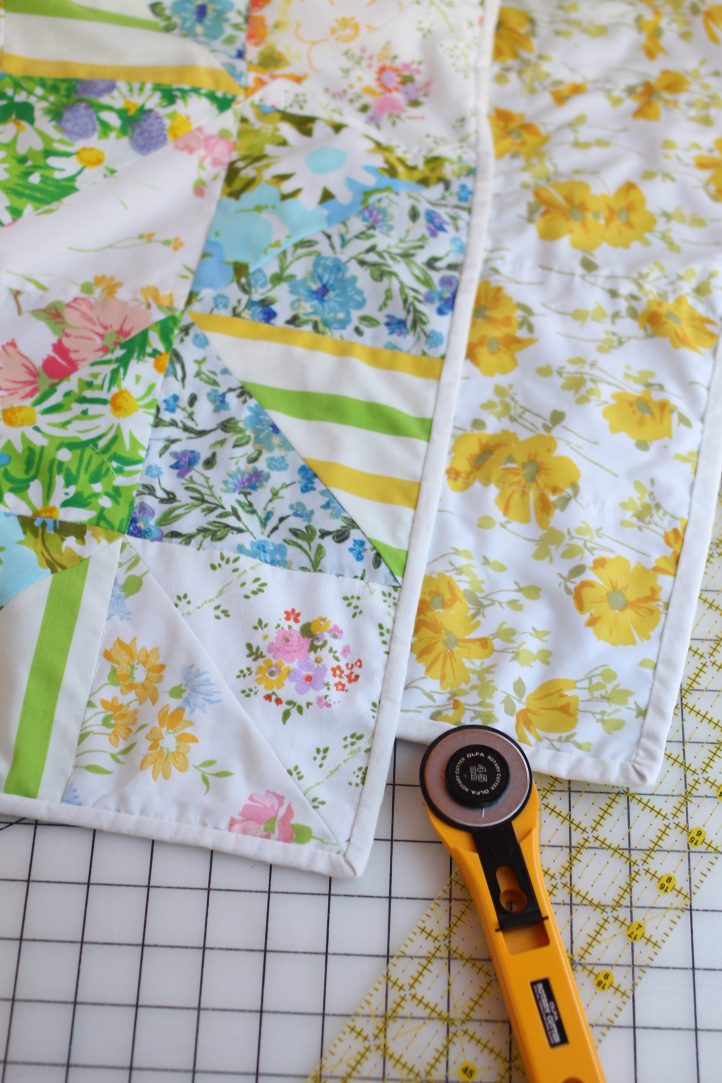
An Introduction to Sustainable Quilting
Ask most people to describe a quilt and they’ll immediately talk about patchwork- sewing small pieces of fabric together in a pattern to make a larger top. In United States’ history, this practice was rooted in practicality, with pioneers using old feed sacks and clothing to make blankets when yardage was expensive and hard to acquire.
According to Abby Glassenberg in her article “The Size of the Quilting Market: Quilting Trends Survey Results 2022” for Craft Industry Alliance, modern day quilting has evolved into a billion-dollar industry, with a vast sea of regular new fabric releases, gadgets, and gear. Alongside the growth of conventional quilting, more awareness has been raised in recent years about the importance of considering sustainability within the quilting world.

Photo provided by Stephanie Woodson
Why Does Sustainability in Quilting Matter?
According to the latest statistics from the Environmental Protection Agency in their article “Textiles: Material-Specific Data” on textile production and recycling from 2018, 17,030 tons of textiles were generated. Out of those 17,030 tons, only 2,510 were recycled with the remaining 14,520 burned or trashed. While this figure doesn’t separate out fabric intended for sewing vs. finished garments or bedding, it is clear that massive amounts of fabric are crowding landfills.
Considering sustainability in quilting can affect that problem in two ways. First, by reducing purchasing yardage on the front end, fewer resources like water and electricity are used with fewer carbon dioxide emissions. The same is true when using upcycled materials to quilt with since they don’t require any resources at all to create. Second, by using upcycled materials, fewer tons of clothing end up in the waste stream to be burned or buried.
When asked about how using upcycled materials in quilting felt meaningful to her, sustainable quilting enthusiast and activist Erin Bauchan shared: “ While I have always enjoyed the thrill of the hunt involved with secondhand shopping, the importance of repurposing as part of my creative process becomes even clearer in the wake of natural disasters such as what we have seen with Hurricane Helene. Our actions as consumers directly impact the world that we live in and can either contribute to speeding up or stabilizing climate change impacts. I personally challenge myself to use at least one thrifted or repurposed material in each project to help do my part and I encourage you to give it a try as well.” You can follow Erin on Instagram at @seamrippersociety.

Photo provided by Stephanie Woodson
Tips for Making Quilting More Sustainable
The classic “3 Rs” can apply easily to quilting, too – reduce, reuse, and recycle! Making small changes and being more thoughtful about purchasing is a step in the sustainable direction.
- Buying less fabric. Social media is teeming with memes about having a huge fabric stash and how fabric shopping is its own hobby, but overconsumption to the point of having more fabric than could be used in a lifetime isn’t much different from a closet bursting at the seams with clothes. Simply buy less fabric. Adding fabric to your cart and waiting 24 hours to purchase can clarify if it’s exactly what you need or want and reduce impulse buying.
- Buying fabric mindfully. “Fast fabric” bought cheaply is less likely to hold up well over time and more likely to have chemical dyes that are harmful for the environment. Consider looking at fabrics that are OEKO-TEX® certified, which means their production is less harmful to the planet and safer for human skin; you can visit OEKO-TEX®’s website to learn more. Quilters can also consider looking for fabrics dyed with natural pigments, small batch production artisans who print or dye yardage, as well as simply buying less and only when you need it.
- Shopping secondhand. There are several ways to buy secondhand fabric! In person, there are estate sales as well as creative reuse stores or sewing/craft focused thrift stores (you can visit Stephanie’s article “A creative reuse center near me map resource!” on her site SwoodsonSays to view the worldwide map to see what’s near you). Online, there is Ebay, Facebook marketplace, or you can search for ‘deadstock fabric store’ and shop designer fashion line leftovers from a place like Fabscrap (visit Fabscrap’s website to learn more).
- Upcycling. Instead of purchasing fabric at all, consider using old clothes and sheets to make quilts! These can be purchased in lots off Ebay, thrifted locally, or you can ask for donations on your local Buy Nothing group. If you don’t mind a little digging, it is easy to find high quality cotton, denim, flannel, and linen to cut up and make a new quilt. Old sheets can also be great quilt backings and binding material, or even used in place of batting for a nice summer-weight quilt.
- Keeping scraps out of the trash. Another aspect of making quilting more sustainable is reducing the amount of trash it produces. There are lots of scrap quilt patterns and tutorials out there, but if that isn’t appealing, consider finding a textile recycling site near you. 100% cotton fabric can be composted, and any fabric can be shredded up and used as filler for pincushions, footstools, and dog beds. Also think about asking a local preschool or art teacher if they can use fabric scraps as a makerspace material. This also applies for batting scraps – keep all the trimmings and turn them into a new sheet of batting with this by using a ‘franken-batting’ technique (you can read the handy article “Frankenbatting – how to join batting pieces” on Penny Spool Quilts website).
- Mending and upcycling existing quilts. No matter how sustainable the original quilt’s materials were, mending an existing quilt and extending its lifespan is an important part of sustainability. Binding can be replaced, patches can be stitched on, and stains can be covered. Once a quilt is beyond repair, consider upcycling it into an accessory or selling it as a “cutter quilt” for another maker to reinvent it before trashing it.
- Reinvent or rehome. When feeling creatively stuck, it’s easy to order new fabric instead of working on an unfinished project but that same thrill of new yardage can be recreated in a more sustainable and creative way. This tip comes from Sarah Flynn, a textile artist/teacher/speaker who teaches a virtual and in person “Sustainable Quilting Unveiled” lecture, which can be purchased on the Offbeat Quilts website: “It’s okay to let it go. Whatever is weighing on you in your sewing space, like a quilt top that has been waiting for years to be finished, there are places and people who would love to have it. Donate quilt tops to charity sewing programs. Drop off unfinished blocks that you don’t want to finish to a local quilt guild’s free table. Organize a ‘cut it up’ challenge among sewing friends, where you swap unfinished projects with the challenge to cut them up and create something new with the materials.”
